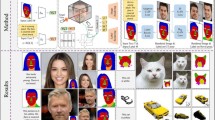Abstract
In the gait recognition, dependency to the walking direction is serious problem because most features obtained from gait sequences for recognition vary with dependent to the walking direction. To extract steady features from the gait sequence in this case, it is noticeable approach to synthesize gait sequences to the canonical-viewed ones. However, even though the synthesized gait is used for the feature extraction, it is required to describe the gait sufficiently for robust recognition. Therefore, the target of this paper is to find a method to reduce the directional dependency, and then apply adequate description for the gait sequences to recognize the gait, which includes a few distortion caused by synthesizing method. To overcome the problem of directional dependency, we propose a synthesis method to compose gait sequences to the canonical-viewed ones based on the planar homography, which is estimated by only using the given gait sequence with simple operation.
The estimated homography by our method is not perfect transformation to make the canonical-viewed gait sequence. Thus, to describe an individual gait sufficiently, we adopt the Shape Sequence Descriptor (SSD), which describes shape information and variation caused by motion, simultaneously. In general, the SSD is used for recognizing motion, which is presented by the fixed object, or person. Thus, it does not be directly applied to the gait recognition because gait sequences is accompanied with positional change, and all of features in the SSD is not significant to the gait recognition. Thus, we modifies the SSD to apply our recognition method, and also, select features according to the significance for recognizing gaits.
From the experiment with real gait sequences, in the restricted condition where the directional dependency has controlled by using the perpendicular gait sequences, the proposed synthesizing method outperforms the method based on simple normalization in the size by about 10 %. In the case using different directional gait sequence, performance of the method using the normalization dropped drastically by 44 % referring to the perpendicular case. It is caused by the effect of directional dependency in the gait sequences. However, the proposed synthesis method improves the performance by about 20 % comparing to the normalization method. From these results, we verify the proposed method can successfully compensate the variation due to the direction of walking and show the reasonable performance of gait recognition.








Similar content being viewed by others
References
Niyogi S, Adelson E (1994) Analyzing gait with spatiotemporal surfaces. In: Proc IEEE workshop non-rigid motion, pp 24–29
Cunado D, Nixon MS, Carter JN (1999) Gait extraction and description by evidence gathering. In: Proc of 2nd int conf on audio- and video-based biometric person authentication, pp 43–48
Wang J, She M, Nahavandi S, Kouzani A (2010) A review of vision-based gait recognition methods for human identification. In: Proc digital image computing: techniques and application, pp 320–327
Nixon MS, Carter JN, Nash JM, Huang PS, Cunado D, Steveage SV (1999) Automatic gait recognition. In: IEE colloquium on motion analysis and tracking, pp 1–3
Nixon MS, Carter JN (2004) Advances in automatic gait recognition. In: Proc int’l conf automatic face and gesture recognition, pp 139–146
Boyd JE (2004) Synchronization of oscillations for machine perception of gaits. Comput Vis Image Underst 96:35–59
Bashir K, Xiang T, Gong S (2010) Gait recognition without subject cooperation. Pattern Recognit Lett 31(13):2052–2060
Han J, Bhanu B (2006) Individual recognition using gait energy image. IEEE Trans Pattern Anal Mach Intell 28(2):316–322
Xue Z, Ming D, Song W, Wan B, Jin S (2010) Infrared gait recognition based on wavelet transform and support vector machine. Pattern Recognit 43(8):2904–2910
Martin-Felez R, Mollineda RA, Sanchez JS (2011) Human recognition based on gait poses. In: Proc 5th Iberian conf on pattern recognition and image analysis, pp 347–354
Veeraraghavan A, Chowdhury A, Chellappa R (2004) Role of shape and kinematics in human movement analysis. In: IEEE conf on computer vision and pattern recognition, pp 730–737
BenAbdelkader C, Cutler R (2002) View-invariant estimation of height and stride for gait recognition. In: Proc ECCV workshop on biometric authentication, pp 155–167
Lee L, Grimson WEL (2002) Gait appearance for recognition. In: Proc ECCV workshop: biometric authentication, pp 143–154
Zhang R, Vogler C, Metaxas D (2007) Human gait recognition at sagittal plane. Image Vis Comput 25(3):321–330
Gross R, Shi J (2001) The CMU motion of body(MoBo) database. Technical report, CMU-RI-TR-01-08
Roy-Chowdhury AK, Kale A, Chellappa R (2003) Video synthesis of arbitrary views for approximately planar scenes. In: Proc IEEE conf on acoustics, speech and signal processing, vol 3, pp 497–500
Choi MS (2004) An efficient representation and matching of a moving object in silhouette. PhD thesis, Hanyang University
Littel JJ, Boyd JE (2003) Recognizing people by their gait: the shape of motion. In: Proc of IEEE conf on acoustics, speech and signal processing, pp 497–500
Hartley R, Zisserman A (2000) Multiple view geometry in computer vision. Cambridge University Press, Cambridge
Bober M (2001) Mpeg-7 visual shape descriptors. IEEE Trans Circuits Syst Video Technol 11:716–719
Bhattacharyya D, Das P, Bandyopadhyay SK, Kim T-h (2008) IRIS texture analysis and feature extraction for biometric pattern recognition. Int J Database Theory Appl 1(1):53–60
Das P, Bhattacharyya D, Bandyopadhyay SK, T-h K (2009) Person identification through IRIS recognition. Int J Security Appl 3(1):129–148
Sarkar I, Alisherov F, Kim T-H, Bhattacharyya D (2010) Palm vein authentication system: a review. Int J Control Autom 3(1):27–34
Author information
Authors and Affiliations
Corresponding author
Rights and permissions
About this article
Cite this article
Jeong, S., Kim, Th. & Cho, J. Gait recognition using description of shape synthesized by planar homography. J Supercomput 65, 122–135 (2013). https://doi.org/10.1007/s11227-013-0897-8
Published:
Issue Date:
DOI: https://doi.org/10.1007/s11227-013-0897-8




